ISSN 2348-1196 (print)
International Journal of Computer Science and Information Technology Research ISSN 2348-120X (online) Vol. 8, Issue 3, pp: (86-99), Month: July - September 2020, Available at: www.researchpublish.com

ISSN 2348-1196 (print)
International Journal of Computer Science and Information Technology Research ISSN 2348-120X (online) Vol. 8, Issue 3, pp: (86-99), Month: July - September 2020, Available at: www.researchpublish.com
1,2,3,4Kulliyyah of Information and Communication Technology
International Islamic University Malaysia, Kuala Lumpur, Malaysia
Abstract: For many decades, the world is struggling to provide quality education and thousands of students/youth in Malaysia failed to complete their education. The trend of dropout among school students is a concern in Malaysia yet resulted in a decrease of graduate employability. The challenge of school dropouts raises even more concerns in the current world situation, Covid-19. In this pandemic, most business and educational activities are forced to be conducted online. The B40 community should not be left behind to access education and jobs. The design and system thinking approach has been adapted in this paper to address the wellbeing issues including dropout and unemployment of B40 youth in Malaysia through understanding their needs, and then followed by building conceptual business models using modelling tools, i.e. Business model canvas(BMC) and Value proposition design canvas(VPC). The approach includes conducting literature reviews of similar programs implemented in other countries and also interviews to understand the needs, key problems and to formulate the initial BMC. Results of the Cash Conditional Transfer program implemented in Cambodia, Philippine and Brazil shows the positive result in addressing school dropout issues. This paper offers validated conceptual Malaysian UotF business models with focus on community engagement programmes. The value proposition of the conceptual business model is to enhance the wellbeing of B40 youth including reducing dropout and unemployment rate in Malaysia through humanising digital entrepreneurship education activities and harnessing the digital capability in implementing a Monetary-Transfer Program (MTP) in Malaysia.
Keywords: B40 Youth, School dropout, Humanising Education, Digital Platform, SDG4, BMC, CCT, Wellbeing, University-of-the-Future.
School dropout rates in Malaysia shows a declining number, however, Malaysia strives to ensure all students get their education. Students who secure an education have a bright future to improve their lives. Dr Maszlee Malik, a former Education Minister, in his speech stated that poverty is one of the challenges of school dropout (Amran, 2018). Due to the financial problems, underprivileged families have difficulties to send their children to school. The statistics of poverty rates in Malaysia shows a wider gap between urban and rural areas from the period of 2014 until 2016 (Mahidin, 2017). From the statistics, Kelantan, Sabah, Sarawak and Kedah states require much attention to deal with the high poverty rates compared to other rural areas in Malaysia (World Bank Group, 2019). The students in those rural areas are not accessible to quality education (Yussop, 2015).
ISSN 2348-1196 (print)
International Journal of Computer Science and Information Technology Research ISSN 2348-120X (online) Vol. 8, Issue 3, pp: (86-99), Month: July - September 2020, Available at: www.researchpublish.com
In order to eradicate poverty, Mexico started a program called Oportunidades (previously known as Prospera), it is a Conditional Cash Transfer (CCT) program which provides fixed monetary-transfer to families whenever their children attend classes. EduSmart is a digitized version of Oportunidades. The focus of this app is to reduce the number of students drop out from the education system. The issue arises from the economic factor in which many lower income families did not have enough financial resources to send their children to schools. However, due to closure of schools caused by Covid-19, many students were unable to attend schools and the education approach changed to e-learning. Besides, Covid-19 outbreak infected their income especially to B40 families who lost their jobs and businesses. With the ongoing issue of Covid-19, it is a challenge for B40 students to access e-learning. Meanwhile, Chief statistician, Mohd Uzir Mahidin in his remarks stated that the unemployment rate rising due to Covid-19 cases and mentioned 610,500 people are jobless in March (Hassan, 2020).
This project is targeted for B40 students/youth who will benefit from a balanced education and the monetary-transfer incentives provided by the government will be sent to the vulnerable groups. According to the statistics published by the World Bank in 2019, poverty in rural areas is higher than in urban areas. Therefore, this project will be focused on the families in selected rural areas in Malaysia such as Kelantan, Sabah, Sarawak and Kedah states. The concept of this mobile application mainly builds on the motto "earn as you learn", focusing on helping underprivileged children to acquire education and motivate their families to send their children to schools and universities. In line with the purpose of improving the quality of education, B40 students will be exposed to soft skills training programs throughout the learning process. In the long run, it will benefit others again in which the students can contribute their skills and knowledge back to the society.
The report “2017 Global Youth Wellbeing Index” by International Youth Foundation, stated the world today has a larger generation of youth than ever before. Half of the global population is now under the age of 30, which is having a dramatic impact on every aspect of the society. When these youths are educated, engaged and empowered, they can become effective agents of change, shaping the world for a better place to live. But when their needs are overlooked, we see alarming trends of a growing number of young people who are unemployed, under-educated, and generally disaffected (ILO, 2020). The basic question to be addressed by this conceptual paper is: “are we creating a world in which B40 youth in Malaysia can enhance their wellbeing and become balanced people - as adults, parents, ethical entrepreneurs and responsible citizens?”
The World Bank Group (2020) mentioned in their blog that they estimated the pandemic to push about 49 million people into extreme poverty in 2020. In the long term of pandemic, the impacts of early childhood interventions, health checkups, and lost months of schooling can be particularly affecting the children in poor families as much as affecting human capital development and earning potential. Therefore, in accordance with the goal of education for all by University of the Future (UotF), the main objective of this program is to help B40 students especially in rural areas and youth who have lost job opportunities during the pandemic and post-pandemic situation. We noticed that the B40 category students mainly could not afford education as education is expensive, there are so many things to pay in order to get education such as tuition fees, additional tuition fees, book fees, and curricular fees. Even public primary and secondary schools require a number of fees. This is why we came up with EduSmart to help them get the quality education they need.
The United Nations mentioned the importance of quality education and it is placed on the UN‟s 4th sustainable development. Besides that, we came up with an idea to build a conceptual UotF business model to digitalize the original idea of MTP, Progresa/ Oportunidades and bring it to Malaysia. MTP is to reduce the poverty rate by increasing the knowledge and skills of the youth in the B40 community. The purpose of this study is to analyze the need for MTP in Malaysia to ensure all students are accessible to quality and balanced education. The program also helps to enhance their soft skills and the appropriate hard skills to survive in the real world such as working life. In this program, we will work closely based on the business plan (UNDP on CCT programme report, 2011) of Progresa or Oportunidades, a conditional cash transfer program administered by the Federal Government of Mexico, with few changes based on the situation in Malaysia's poor community and the readiness of Malaysia‟s government towards this approach.
ISSN 2348-1196 (print)
International Journal of Computer Science and Information Technology Research ISSN 2348-120X (online) Vol. 8, Issue 3, pp: (86-99), Month: July - September 2020, Available at: www.researchpublish.com
The methodology adopted in this paper is the design and system thinking approach to develop a conceptual business model of a Malaysian-based UotF- focusing on implementing relevant international community engagement programmes and activities. The value proposition of the conceptual business model is to enhance the wellbeing of B40 students/youth in Malaysia through humanizing entrepreneurship education and by harnessing the use of digital/IR4.0 capability and platform. The conceptual business model is developed through understanding the needs of B40 youth in this current world situation. The business model used in the form of Business Model Canvas (BMC) and Value Proposition Design Canvas (VPC). BMC (AG. S, 2020) consists of nine building blocks; customer segments focus on the target customers, value proposition seeks to solve customer problems, a channel is deliverable through communication, customer relationship focus on keeping a customer for the business, revenue streams is the result from the deliverable of the value proposition to the customer, key resources are the assets required to offer and deliver the value proposition, key activities is performed activities, key partnerships, and cost structure (Jungthawan, Siripong & Pomcum, C & S, V & J, Natnawat, 2017).
VPC is a tool that breaks the problem of identifying the value proposition down into the discrete part, it assists to match business services to customer needs. VPC consists of two components; value map and customer profile. Value map consists of gain creators which elaborate on what kind of offer business owners could provide to the customer, products and services, and pain relievers. On the other part, the customer profile consists of gains, job-to-be-done, and pains (AG. S, 2020). The approach involves carrying out literature reviews and interviews to identify key challenges and issues of various customer segments by formulating and devising an initial conceptual business model. The initial BMC is validated by interviewing STUFF‟s and Sendi‟s president and other vice presidents as they are really proactive in helping the B40 and needy youth community, even more for educational purposes for the concerned community. The findings can be found at section 6.2 Enhanced Business Model. Their usual main concerns are for school children and they provide facilitating and soft skills training such as leadership activity, motivational talks and brainstorming sessions to encourage high order thinking skills in children. These clubs often visit schools that are in rural areas or schools that are seeking for facilitating services. Some of the schools that STUFF has visited in their previous projects are SK Seri Machap, Johor and SK Parit Melana, Melaka. We managed to have an eye to eye conversation on providing this monetary education program to provide aid and collaboration. Besides that, the initial VPC is also validated by interviewing other customer segments such as NGOs and identified government organizations to discuss the potential ideas and agreements regarding EduSmart projects. The findings are listed in section 6.2 Enhanced Business Model. As for initial BMC status, all of the approached customer segments agreed to cooperate and compromise for this cause. Design thinking methodology is a methodology that encompasses a customer-oriented innovation approach that aims to generate and develop creative business ideas or entire business models. It is an attempt to design projects and methods for the business process. There are six phases of design thinking, understanding the problem, observing, defining the problem, finding and selecting ideas, developing the prototype, and last but not least, testing. In this project, the digital platform of a mobile application is designed based on the design thinking approach (Müller-Roterberg, C, 2018).
The success of a nation is measured by the sustainability performance and accessibility for all. In today‟s world, the biggest problem among nations is to solve development issues. Over the past years, the agenda of Sustainable Development Goals (SDG) introduced to help retain the development in the future. According to Mahidin (2017), rural areas indicate the highest poverty rate and show a 0.8% difference from urban poverty. People in rural areas are the main targeted group to improve income prospects in order to tighten the gap.
The objective of dealing with the poverty issue is significant to SDG1. Malaysia faced a challenge to diminish the issue of school drop-out resulting from the poverty factor. Malaysia is concerned about the accessibility of education for all. SDG4 which emphasizes improving balanced and quality education will help Malaysia to enhance social well-being, closing the gap between socio-economic groups and breaking the cycle of poverty. SDG8 works on decent work and economic growth is the key indicator for Malaysia to increase the productivity of the labor force and reduce the proportion of youth unemployment. It will increase graduate employability in the future. In SDG9 which is industry, innovation and infrastructure, the digital cash transfer program met this objective. The proper planning to widen internet coverage in rural areas will increase the usage of the internet and be accessible to all.
ISSN 2348-1196 (print)
International Journal of Computer Science and Information Technology Research ISSN 2348-120X (online) Vol. 8, Issue 3, pp: (86-99), Month: July - September 2020, Available at: www.researchpublish.com
Malaysia is seen to have a high chance to strive for zero school drop-out. The statistics over years showed a decreasing pattern on this issue, however, Malaysia needs to have an effective program to flatten the school drop-out rate. Countries that have implemented a cash transfer program show a positive impact on the school attendance. Cash transfer program in Philippine called Pantawid Pamilyang Pilipino Program (4P) has motivated parents to send their children to schools. Based on the research, the poor families could afford to pay school fees, stating the difference by 23.7 percent from 64.30 percent (Flores et al., 2019, p. 202). Meanwhile, the case in Cambodia shows the improvement of class attendance among poor children. With the cash grant, it increases school attendance by 0.77 percent (Meng, C. & Pfau, 2011, p. 15).
According to the Department of Statistics, B40 families are the classified group whose median income is RM 3000. In this MTP, B40 families are eligible to receive monetary assistance to help their children access their education. Due to the pandemic cases of Novel Coronavirus 2019 (Covid-19), the government of Malaysia has taken initiative to help those infected, especially B40 groups. Malaysia‟s government allocated RM 10 billion to help B40 groups, as well as M40 groups and B40 groups, are entitled to get RM 1600 cash handout (Ang, 2020). With government assistance, they can improve their quality of life.
Due to technological innovation, Malaysia is not lagging behind by embracing the industrial revolution (IR) 4.0. A few years back, Malaysia has set new initiatives in education and companies to move towards industry 4.0 such as emphasizing on demanded IR 4.0 skills. Many universities have been promoting Education 4.0 and transforming to the new trend of technology in the learning revolution (Karim et al., 2018, pp. 34-39). In the meantime, it increases technology literacy among students.
During the Covid-19 outbreak, digital platforms were seen to benefit Malaysians in many ways. The Government of Malaysia has taken a new approach remotely to monitor interstate travel. Malaysian Communications and Multimedia Commission (MCMC) has developed an application called „Gerak Malaysia‟ which allows stranded citizens to apply for a permit to return home and the app is generated QR code for each user (Tariq, 2020). This app has been used by 500,000 users since the Movement Control Order (MCO) to help users to request their travel (Bernama, 2020). Besides, Malaysia used an application of MyTrace to trace any contact of positive patients using Bluetooth and GPS technology (Bernama, 2020).
In order to make the project work, Malaysia needs some improvement on the performance of the internet networks (“National Industry Policy 4.0 Policy Framework”, n.d.). It shows that internet connectivity must be strong to ensure the accessibility and good connection of the information digitally. During the MCO issued due to the case of Covid-19, many universities and schools decided for remote learning. The rise of e-learning caused students to have access to the internet. Malaysia's government has decided to provide a free internet connection to support the e-learning approach in which students can enjoy free access of 1GB internet from a certain time limit (“Building The Economy Better”, 2020, p. 19). Hence, B40 students who have problems would not be left behind for online learning.
According to the Global Youth Wellbeing Index (2017), the International Labor Organization‟s Youth defined youth is people with a range of 15 to 24 years old. Whilst in Malaysia, reported by Prof Madya Dr. Faizah Yunus, “The National Youth Development Policy of Malaysia defines people with 15 to 40 years old as youth, however youth in the age of 18 to 25 years old are the main concern for youth development”. Youth plays an important role in progress and innovation society in order to shape for the betterment of the future. By having a mental and physical balance, youth can achieve high levels of wellbeing. The report in Global Youth Wellbeing Index describes the top priorities that need concern by the youth are knowledge and skills that empower youth to build long-term wellbeing. Securing education helps youth to gain skills, knowledge and deliver the values to the community. In order to achieve a positive outcome, youth need a healthy surrounding and caring community to grow well. The support from the environment gives a huge impact to improve a person's life. Community engagement like the CCT program is a good foundation to solve youth difficulties in accessing education, provide training and skills in preparing for future opportunities.
ISSN 2348-1196 (print)
International Journal of Computer Science and Information Technology Research ISSN 2348-120X (online) Vol. 8, Issue 3, pp: (86-99), Month: July - September 2020, Available at: www.researchpublish.com
Progresa/Oportunidades is a Conditional Cash Transfer (CCT) program administered by the Federal Government of Mexico. Based on the UNDP 2011 report on the CCT program, it can be summarized that the business model of Progresa, this program focuses on poor families as their customer segment. Their key partners are the government, health care, and both primary and secondary schools. The value proposition is to improve the economic rate while learning to improve their customer segments‟ life. Their main channel is school and health care services. This program provides direct cash payments to parents in poor communities in Mexico if they send their children to primary and secondary school. In return, they also receive regular preventive care at local health clinics. This program is also adopted by few other countries such as in Asia (the Kyrgyz Republic, Mongolia, Pakistan, and Cambodia, etc.), Latin America and the Caribbean (Chile, El Salvador, Paraguay, etc.) and Africa (Ghana, Malawi, Zambia, Burkina Faso, Kenya, among others). CCT is contributing to overcoming historically high levels of inequality in Latin America and is considered as a right step to systematically reducing poverty (UNDP, 2011). CCT does not use a digital platform as it serves for the poor communities in Mexico. The key features of CCT are the cash transfers for beneficiaries based on specific behavior and condition and the distribution of the nutritional supplement as well as providing free health care services to a household with a child enrolled in school with an attendance rate not less than 85% rate required by Progresa (Skoufias, E. (2001).
University plays an important role in society for over a very long time. In recent technological developments and increasingly complex challenges, university systems are being criticised for not producing adequate-work ready for graduates and for their intense focus on research which sometimes has been at the cost of their mandate to educate (Dan et al., 2019). Therefore, a group of academicians and other parties consider redeveloping and improving universities in the future. They emphasise that university should be about education and individual exploration through discussions and readings that broaden the mind, a different way to examine knowledge to enhance the ability to face challenging situations and the ability to come up with critical and satisfactory solutions to problems. Furthermore, the arrival of digital technologies and the Industrial Revolution (IR) 4.0 into the learning process has radically changed the way faculty and students access and share knowledge. Focusing on the principle of „Education is for all‟, UotF is possible to broaden the access to education for a larger portion of society (Cohen et al., 2020; Dahlan et al., 2020; Ibrahim & Dahlan, 2016).
The initial Business Model – in the form of BMC and VPCs, was made based on literature reviews and design thinking (DT). BMC is a tool used to provide a deeper understanding of a business model in a structured way. It gives insights about customers served, value propositions offered through channels and how a company makes revenues (AG, 2020). On the other hand, the Value Proposition Canvas (VPC) is a tool to tackle the core challenges of the business and to understand what the customer wants and needs. (AG, S., 2020). To provide a reliable mobile application, EduSmart is designed based on a design thinking approach. Based on Interaction Design Foundation, DT is an iterative process to understand users, redefine problems by creating a prototype and test innovative solutions.
I. Initial Business Model Canvas (BMC) Fig 1: Initial Business Model Canvas
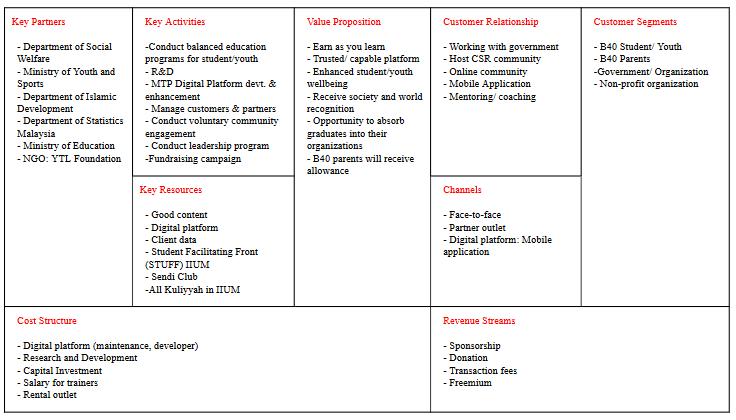
ISSN 2348-1196 (print)
International Journal of Computer Science and Information Technology Research ISSN 2348-120X (online) Vol. 8, Issue 3, pp: (86-99), Month: July - September 2020, Available at: www.researchpublish.com
Fig 2: VPC for B40 Students/Youth
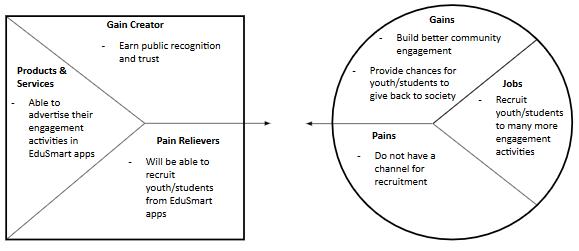
Fig 3: VPC for B40 Parents
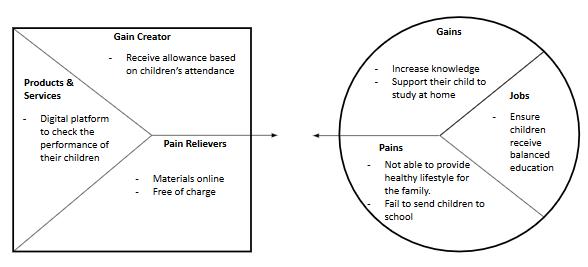
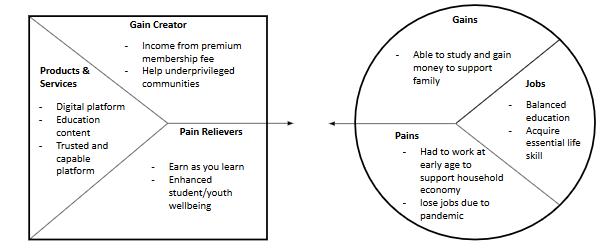
Fig 4: VPC for Government/ Organization
Fig 5: VPC for Non-profit organization
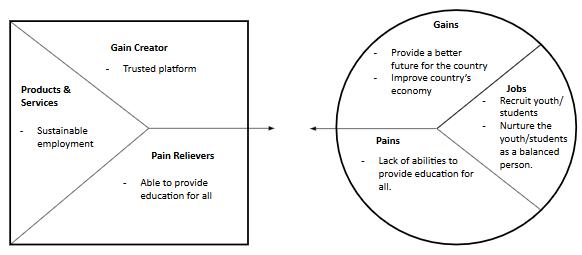
ISSN 2348-1196 (print)
International Journal of Computer Science and Information Technology Research ISSN 2348-120X (online) Vol. 8, Issue 3, pp: (86-99), Month: July - September 2020, Available at: www.researchpublish.com
As mentioned in the above section (Methodology), the Business model consists of two main components which are BMC and VPC. Our initial BMC is validated after a few meetings and interviews with the current president and vice presidents regarding our project focus, main concern and how we are planning to achieve it as well as our proposed resources. We have also come up with project expectations from their sides and what can we do to contribute and help each other to make this project a success. VPC are validated after contacting other NGOs, government organizations such as stated in our BMC‟s Key Partnership to allow brainstorming activities. Lack of resources might be a challenge and this is why several meetings and discussions on expectations are important before proceeding to approve and validate this project. It has come to the last step that our initial Business Model is validated by various organizations from BMC and VPC.
The findings or the outcomes of the Validation Process has reached the consensus of supporting facilities on partner outlets. They have also agreed to provide a certain amount of financial aid by conducting donations on their behalf. Other than that, YTL foundation agrees to support free 40Gb data and free smartphones to allow them to study from home because of the impact of this pandemic. Furthermore, mosques and surau in nearby rural places allow their spaces to be used for physical learning during certain times on the weekdays and weekends with a small rent payment for the spaces allocated. Besides that, IIUM STUFF and Sendi club offer a workforce for facilitators and teaching materials for the B40 students.
The interview was conducted to 7 respondents consisting of 4 respondents from STUFF club and the others are from SENDI club.
The result shows a majority of respondents which is 85.7% agree that the B40 community contributes to the drop out issue. Therefore, EduSmart project focuses on the B40 group to tackle this issue.
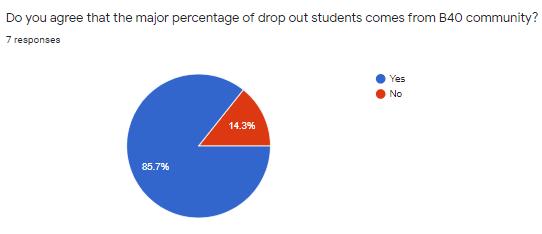
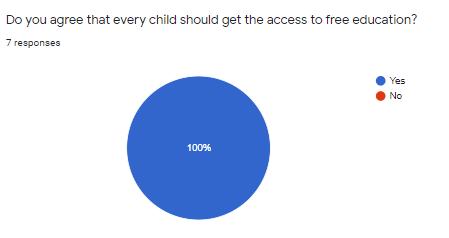
ISSN 2348-1196 (print)
International Journal of Computer Science and Information Technology Research ISSN 2348-120X (online) Vol. 8, Issue 3, pp: (86-99), Month: July - September 2020, Available at: www.researchpublish.com
According to the interview, all respondents agree the accessibility of free education should be given to children. In order to achieve that, EduSmart provides a platform for students to get free education.
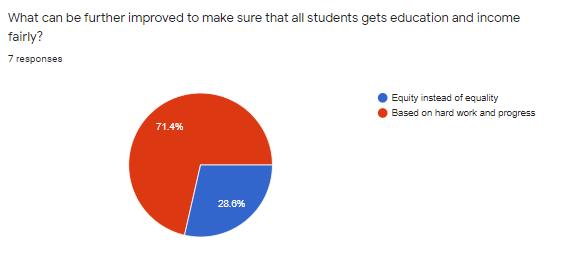
Majority of respondents found it necessary to have tracking features in EduSmart‟s project. 85.7% of respondents agree that parents should be allowed to track a student's performance. In our project, the tracking feature needs to be added to ensure the parents can monitor their children's performance during the learning process.
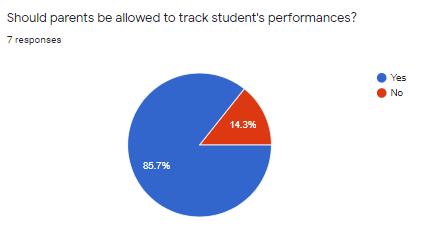
During the interview session, the importance of students from the B40 community is prioritized and then further discussed on what are the partners‟ aid capabilities to offer for this project. After narrowing down, all respondents agreed that everyone should get their rights to education they all needed for their mental growth and intellect as included in one of the interview questions. Based on the votes above, we can see that most facilitators from STUFF and Sendi voted for hard work and progress which means that students who perform in class shall be awarded with the right amount of financial rewards to support their family. This is a good idea as it can motivate students to study. The idea is not to neglect the least performed student but as long as they put in the hard work, facilitators may give appropriate markings for financial rewards.
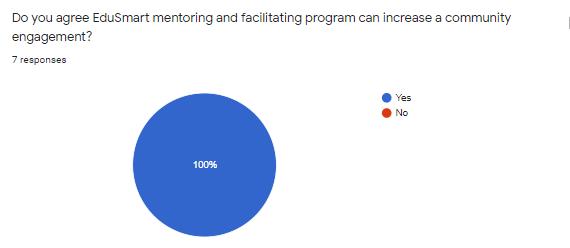
ISSN 2348-1196 (print)
International Journal of Computer Science and Information Technology Research ISSN 2348-120X (online) Vol. 8, Issue 3, pp: (86-99), Month: July - September 2020, Available at: www.researchpublish.com
Besides that, respondents were asked on how engaging the EduSmart program is and how it can benefit the future community engagement. As seen above, all respondents agreed that EduSmart mentoring and facilitating is beneficial towards community engagement as when the students have graduated from their studies, they can always return and be absorbed to become the facilitators, so, in a way around, everything the students gain will be practical for them to apply and benefits other youths in the future. These steps are taken to reach the goal of zero school dropout rates in Malaysia and increase community engagement by offering job opportunities to EduSmart students.
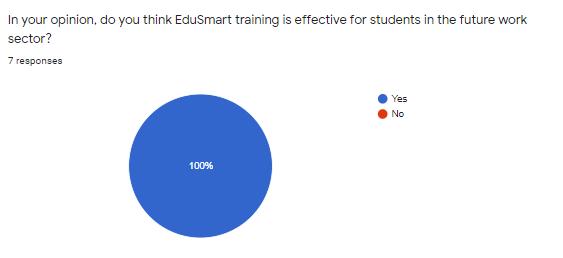
Fig 11: EduSmart efficiency for student’s future in working sector
Finally, EduSmart must produce a quality and good standards of education for the student‟s age groups so that they will not miss out on big examinations in Malaysia such as PT3 and SPM. Asking this question is vital to make sure that the syllabus provided by the partners are in accordance with the standardized education set by the Ministry of Education. Beside this, the facilitators are expert in providing leadership and educational training programs to build up the students‟ soft skills which are vital for their future. To secure any jobs in the future, candidates will need to be able to have excellent interpersonal and soft skills for job interviews. This is why EduSmart prioritizes the soft skills training of their students.
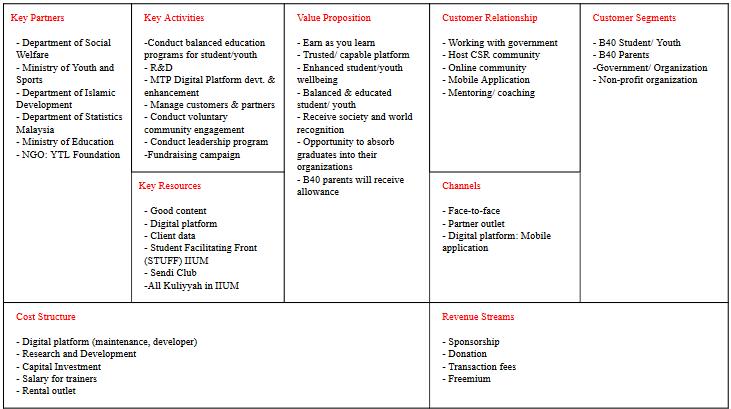
VPC and BMC are enhanced to provide the granularity of customers by adding the dimension of customers' gains, pains and job.
Fig 12: Enhanced BMC
ISSN 2348-1196 (print)
International Journal of Computer Science and Information Technology Research ISSN 2348-120X (online) Vol. 8, Issue 3, pp: (86-99), Month: July - September 2020, Available at: www.researchpublish.com
The value proposition defines the value of the project to the Customer Segments. The term "earn-as-you-learn" is implemented as B40 parents will be given an allowance if their family member's school and IHLs attendance meet a certain percentage. A trusted and capable platform will be created for B40 youth or students in order to give a balanced education to the youth and students. The objectives of the program are to enhance wellbeing which includes reducing inequality, therefore, the curriculum will be ensuring that essential life skills as well as entrepreneurship skills and management skills are learned for them to be ready to confront challenges in the future. To provide a balanced and appropriate knowledge, the ability to resolve conflicts ethically, critical thinking and other abilities will be trained for them to make well-balanced decisions. With all the desired knowledge, skills, and abilities, they will be able to get decent jobs or even become job creators and entrepreneurs. Most importantly, they will have the opportunity to contribute to the sustainability of a harmonious community and wellbeing. Other than that, government and non-government organizations will receive recognition from the society and the world with the intention of helping the underprivileged communities by assisting them in increasing their lifestyle and knowledge. Government and non-government sectors that work together in this project will also have the opportunity to absorb the graduates from this project into their organizations based on terms and conditions. In this project we focused on having non-profit organizations that will help to accommodate us with anything we need such as mobile devices for the poor, a place for training and a volunteer trainer from other non-profit organizations as the team grew bigger and able to afford the continuity of the project.
The customer segments describe different groups of people and organizations that our project aims to serve. This project focuses on customer segments that include B40 students, B40 parents, government, and NGOs. The government gains value by a binding system in which students will work for them in return. Future ahead, students get employed. NGOs will earn benefit from gaining more brand awareness.
The customer relationship is a way of staying connected with the customer segments. To sustain the relationship with the customer, it can be done through online engagement or community, host customer relationship community and to get the students to engage with the government by working with them. Through a monetary transfer platform, customers‟ relationship can be maintained by providing feedback to customers. A website feedback widget will appear on the page to ask open-ended questions to collect customers' feedback to improve customers‟ experience. Other features are interactive services like email, frequently asked questions (FAQ), phone number, and site map to retain customers in the long term.
The distribution channel is the place to deliver the value proposition to customer segments. Face to face, partner outlet, and masjid are the physical distribution to deliver key activities and value proposition to customer segments. Meanwhile, a virtual channel which is a digital platform takes place in this IT project, this is the main focus of EduSmart. Due to current Covid-19, all of the education sectors are terribly affected. Schools, offices, universities, shops, and basically everything is shut down under the Movement Control Order that was announced on March 18th, 2020 until June 9th, 2020. In this period, several amendments have been made to counter a full economy from collapsing for educational sector, there are announcements made by the government to allow only form five (5) students/ 17-years old students to attend back to school as SPM (Sijil Pelajaran Malaysia) which is a big examination for the highest grades have been postponed to next year. As for other grades, there are to continue virtual learning from home as implemented by the Ministry of Education, this includes EduSmart learning management. EduSmart face to face training activities will also be affected and some sectors are jeopardized by this pandemic but the existence and usage of our mobile application will be fully utilized. As per functions of the initial digital platform is for Monetary Transfer Program (MTP) and tracking students‟ progress as well as getting learning materials. Now, other options such as questions, submitting work, and grading will be conducted under the same platform.
The key activities include the Research and Development (R&D) process in which it is needed to study the pattern of dropout students. It is also important to have proper research, data collection of the vulnerable families, and development for this program to study the effectiveness of the program. The research and development of digital platforms, in which a mobile application will be developed, is needed in order to provide a capable and trusted platform for the customer segments. In conjunction with providing a balanced education for everyone, a Student Training Program will be
ISSN 2348-1196 (print)
International Journal of Computer Science and Information Technology Research ISSN 2348-120X (online) Vol. 8, Issue 3, pp: (86-99), Month: July - September 2020, Available at: www.researchpublish.com
established to prepare them with essential and life skills for the future. As much as entrepreneurship and technical skills are trained, this program also focuses on interpersonal skills such as leadership skills and instills the spirit of volunteering to provide back to the communities.
Key resources are the asset of this IT project to sustain the business. This project needs client data in customer segments, particularly for underprivileged families. The competent strategy needed to market this project to the potential customer segments and key partners. Meanwhile, a good content and functional digital are the significant factors in digital platforms to deliver value to key partners. Student facilitating front (STUFF) club and SENDI club are the important internal communities that deliver the key activities to the customer segments. The main objective of the STUFF club is to produce great leaders in the future. It provides leadership and training programs to students which benefit them to gain soft skills. Meanwhile, SENDI club focuses on mentoring and facilitating programs to primary schools. It helps strengthen the students‟ personality. All kuliyyahs in IIUM contributed in terms of providing a training team for students/youth. All kuliyyah works along with STUFF and SENDI club to develop students‟ social skills.
This section is for the external partner to collaborate in the project. The key partners include the Department of Social Welfare to work on social reporting and analyze the social patterns of Malaysian youth. The Ministry of Youth and Sports to help our team in the engagement with the youth. Other than that, the Department of Islamic Development to assist in producing balanced school graduates that include spiritual aspects. The Department of Statistics Malaysia is involved in the R&D process for data analysis and data presentation. The office of the Ministry of Education to collaborate and solve the problem along with this project. During the pandemic, YTL Foundation has come up with an initiative to provide free mobile devices with mobile internet to the vulnerable groups that are eligible. This initiative is to make education available to everyone.
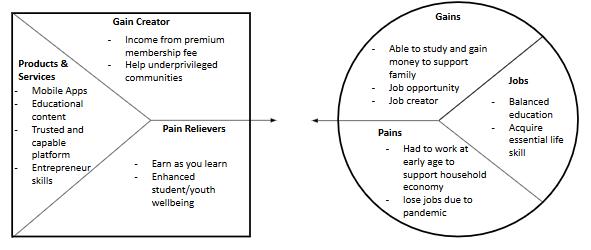
The expenses for this IT project are used to pay for key resources and key activities conducted. For instance, cost to maintain the digital platform, research and development, capital investment, salary for trainers and rental outlet. Usually, any physical training is conducted on a partner's outlet but we also rent masjid and surau that is near to the rural areas to reach the community and gain their trust and support. During this time, our site is fully utilised to the maximum use so the cost to maintain its functionality are also demanding, salary for our trainers must go on as usual.
It consists of strategies to produce return on invested capital. The revenue is earned from sponsorship and donation either by the government, organization or donor. Besides that, EduSmart are also conducting fundraising and transaction fees to collect revenue. The transaction fees give a return to the business in a way that charges fees to customers who want to make cash transfers online. In terms of digital content, this IT project generates profits from freemium strategy which offer certain services for free and charge a subscription fee for freemium level, for example if a student wants to buy additional materials like e-book from authors. Some educational videos might also be price tagged for an affordable fee for B40 students and families.
ISSN 2348-1196 (print)
International Journal of Computer Science and Information Technology Research ISSN 2348-120X (online) Vol. 8, Issue 3, pp: (86-99), Month: July - September 2020, Available at: www.researchpublish.com
Fig 14: Enhanced VPC for B40 Parents
Fig 15: Enhanced VPC for Government/Organization
Fig N: Enhanced VPC for Non-profit organization
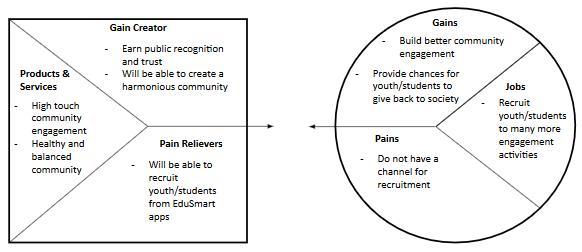
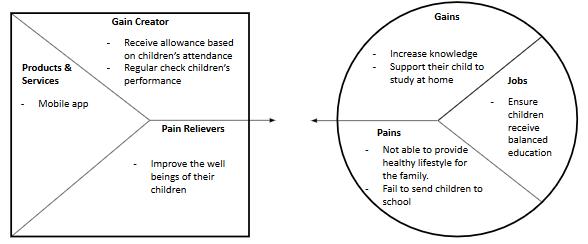
This paper is proposing a monetary-transfer model that is inspired by the CCT programme in the form of digital, an application called EduSmart will cater all the businesses of the programme. Its main objective is to make it easier for the key partners and customers to analyse the data and study the effectiveness of the programme. This project targeted families in selected rural areas in Malaysia such as Kelantan, Sabah, Sarawak and Kedah states. The purpose of this project is to enhance the soft skills and hard skills of the youth, it is also focused on entrepreneur skills because Malaysian UotF is working towards producing holistic graduates that are able to create jobs instead of job hunting. The proposed conceptual business model – in the form of BMC and VPCs, insights the direction of this programme and presents the strategic planning to the upper management. For the future impact, this project can be seen as the first step of resolving the unemployment issue between youths alongside achieving zero dropouts‟ rates in Malaysia.
For the future work, Project Management Plan (PMP) will be done for the monetary-transfer program digital platform, project charter will also be included in the PMP document.
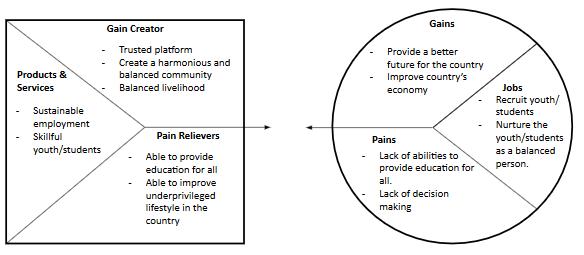
ISSN 2348-1196 (print)
International Journal of Computer Science and Information Technology Research ISSN 2348-120X (online) Vol. 8, Issue 3, pp: (86-99), Month: July - September 2020, Available at: www.researchpublish.com
[1] AG, S. (2020). Business Models & Value Propositions Canvas. Retrieved from https://www.strategyzer.com ok/canvas
[2] Ang, M. V. (2020, March 30). Here's How You Can Claim The PRIHATIN Package One-Off Handouts. Retrieved from Says Web site: https://says.com/my/news/here-s-how-you-can-claim-the-prihatin-package-one-off-handouts
[3] Amran, S. N. (2018, November 29). Education Ministry aims to reduce student dropout rate to 0.27 per cent next year. Retrieved on February, 10, 2020 from https://www.nst.com.my/news/nation/2018/11/435782/educationministry-aims-reduce-student-dropout-rate-027-cent-next-year
[4] Bernama (2020, May 3). Covid-19: 'MyTrace' application to help in contact tracing. Retrieved on June, 6, 2020 from https://www.theedgemarkets.com/article/covid19-mytrace-application-help-contact-tracing
[5] Building The Economy Better. (2020) Malaysia: Ministry of Finance.
[6] Cohen, A., Nørgård, R. T., & Mor, Y. (2020). Hybrid learning spaces Design, data, didactics. British Journal of Educational Technology.
[7] Dahlan, A. R. A., Ibrahim, J., Jalaldeen, M. R. M., & El Mohajir, M. (2020). Redesign “University of the Future” Conceptual Business Model: Sustainability and Staying Relevant in The Digital Age. Journal of Information Systems and Digital Technologies, 2(1), 47–59.
[8] Dan R., Kenneth A G, Shawren S., (2019). The University of the Future.
[9] Flores, M. J., Espinoza, C. A., Enrico, H. C. & Casimiro, R. R (2019). Pantawid Pamilyang Pilipino Program (4Ps): Its Effect on the Academic Performance of Student-Beneficiaries in Calaba National High School in the Philippines. Journal of Public Administration and Governance, 9(2), 193-207.
[10] Hassan, H. (2020, May 8). Most Malaysian companies struggling under movement control curbs, unemployment at a 10-year high. Retrieved from The Straits Times: https://www.straitstimes.com/asia/se-asia/most-malaysiancompanies-struggling-under-movement-control-curbs-unemployment-at-a-10
[11] Ibrahim, I., and Dahlan, A. R. A. (2016), Designing Business Models Options for University-of-the-Future. Proceedings of 2016 4th IEEE International Colloquium on Information Science and Technology (CiSt), Tangier, 24-26 October 2016, pp. 600- 603.
[12] International Labor Organisation (2020). The Global Youth Employment Trends 2020 -Technology and the Future of Jobs.
[13] International Youth Foundation. (2017). Global Youth Wellbeing Index.
[14] Jungthawan, Siripong & Pomcum, Chavayot & Suharitdamrong, Vithaya & Jiwattanakul, Natnawat. (2017). Development of Lean Startup and Global Entrepreneurship Program for Educational Institutions in Thailand.
[15] Karim, R. A., Abu, A. G., Adnan, A. H., Suhandoko, A. D. J., (2018). The Use of Mobile Technology in Promoting Education 4.0 for Higher Education. Advanced Journal of Technical and Vocational Education, 2(3), 34-39. doi: 10.26666/rmp.ajtve.2018.3.6
[16] Mahidin, M. U. (2017, October 9). Report of Household Income And Basic Amenities Survey 2016. Malaysia: Department of Statistics Malaysia. Retrieved from Department of Statistics Malaysia: https://www.dosm.gov.my/v1/ index.php?r=column/cthemeByCat&cat=120&bul_id=RUZ5REwveU1ra1hGL21JWVlPRmU2Zz09&menu_id=am VoWU54UTl0a21NWmdhMjFMMWcyZz09
[17] Meng, C. & Pfau, W. D. (2011). Simulating the impacts of cash transfers on poverty and school attendance: The case of Cambodia. Munish Personal RePEc Archive, 1-33.
[18] Müller-Roterberg, Christian. (2018). Handbook of Design Thinking
[19] National Industry Policy 4.0 Policy Framework. (n.d.). Malaysia: Ministry of International Trade and Industry.
ISSN 2348-1196 (print)
International Journal of Computer Science and Information Technology Research ISSN 2348-120X (online) Vol. 8, Issue 3, pp: (86-99), Month: July - September 2020, Available at: www.researchpublish.com
[20] Skoufias, E. (2001). Progresa And Its Impact On The Human Capital And Welfare Of Household In Rural Mexico: A Synthesis Of The Results Of An Evaluation By Ifpri (No. 600-2016-40135).
[21] Tariq, Q. (2020, April 17). MCMC launches contact tracing app: Gerak Malaysia . Retrieved from The Star Online: https://www.msn.com/en-my/news/other/mcmc-launches-contact-tracing-app-gerak-malaysia/ar-BB12Lu4q
[22] UNDP Poverty Report (2016). Africa Research Bulletin: Economic, Financial and Technical Series, 2016. UGANDA: UNDP Poverty Report. 52(12), pp.21099A-21099C
[23] UNDP (2011) Poverty Reduction Scaling Up Innovations for Transformational Change. 2011. Mexico. Retrieved from https://www.undp.org/content/undp/en/home/librarypage/poverty-reduction/scaling_up_localdevelopment innovations.html
[24] World Bank Group. (2019). Poverty & Equity Brief . The World Bank.
[25] World Bank Group. (2020, April 23). Covid-19 will hit the poor hardest. Here‟s what we can do about it. The World Bank.
[26] What is Design Thinking? (n.d.). Retrieved from https://www.interaction-design.org/literature/topics/design-thinking
[27] Yunus, P. M. (2007). Youth Employment and Employability in Malaysia. Malaysia: Malaysia Youth Report.
[28] Yussop, Y. (2015, December 17). Many rural children lack in education opportunities. Retrieved from Borneo Post Online: https://www.theborneopost.com/2015/12/17/many-rural-children-lack-in-education-opportunities/